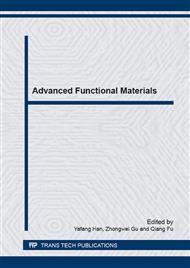[1]
H.F. Mark, S.M. Atlas, N. J. Ogata, Aromatic polyamide, Polym. Sci. 61 (1962) S49-S53.
DOI: 10.1002/pol.1962.1206117225
Google Scholar
[2]
J. Preston, F. Dobinson, New high temperature aromatic polyamides, J. Polym. Sci. Part B: Polymer Letters 2 (1964) 1171-1174.
DOI: 10.1002/pol.1964.110021219
Google Scholar
[3]
R.A. Dine-Hart, B.J.C. Moore and W.W. Wright, Aromatic polyamides, J. Polym. Sci. Part B: Polymer Letters 2 (1964) 369-373.
DOI: 10.1002/pol.1964.110020411
Google Scholar
[4]
J. Preston, New high temperature polymers. I. Wholly aromatic ordered copolyamides, J. Polym. Sci. Part A-1: Polym. Chem. 4 (1966) 529-539.
DOI: 10.1002/pol.1966.150040307
Google Scholar
[5]
F. Dobinson, J. Preston, New high-temperature polymers. II. Ordered aromatic copolyamides containing fused and multiple ring systems, J. Polym. Sci. Part A-1: Polym. Chem. 4 (1966) 2093-2105.
DOI: 10.1002/pol.1966.150040906
Google Scholar
[6]
R.S. Lenk, Post-nylon polyamides, J. Polym. Sci. Macromolecular Reviews 13 (1978) 355-387.
DOI: 10.1002/pol.1978.230130107
Google Scholar
[7]
Y. Zhang, Y. Huang and L. Liu, Effects of γ-ray radiation grafting on aramid fibers and its composites, Appl. Surf. Sci. 254 (2008) 3153-3161.
DOI: 10.1016/j.apsusc.2007.10.081
Google Scholar
[8]
C. Yue, K. Padmanabhan, Interfacial studies on surface modified Kevlar fibre/epoxy matrix composites, Composites Part B 30 (1999) 205-217.
DOI: 10.1016/s1359-8368(98)00053-5
Google Scholar
[9]
R.Q. Cai, T. Peng, F.D. Wang, G.D. Ye, J.J. Xu, Improvement of surface wettability and interfacial adhesion of poly-(p-phenylene terephthalamide) by incorporation of the polyamide benzimidazole segment, Appl. Surf. Sci. 257 (2011) 9562-9567.
DOI: 10.1016/j.apsusc.2011.06.064
Google Scholar
[10]
S.H. Zhang, G.Q. He, G.Z. Liang, H. Cui, W. Zhang, B. Wang, Comparison of F-12 aramid fiber with domestic armid fiber III on surface feature, Appl. Surf. Sci. 256 (2010) 2104-2109.
DOI: 10.1016/j.apsusc.2009.09.055
Google Scholar
[11]
C. Yue, G. Sui, H. Looi, Effects of heat treatment on the mechanical properties of Kevlar-29 fibre, Compos. Sci. Technol. 60 (2000) 421-427.
DOI: 10.1016/s0266-3538(99)00137-2
Google Scholar
[12]
Y. Rao, A. Waddon, R. Farris, The evolution of structure and properties in poly (< i> p</i>-phenylene terephthalamide) fibers, Polymer 42 (2001) 5925-5935.
DOI: 10.1016/s0032-3861(00)00906-x
Google Scholar
[13]
A. Hindeleh, S.M. Abdo, Effects of annealing on the crystallinity and microparacrystallite size of Kevlar 49 fibres, Polymer 30 (1989) 218-224.
DOI: 10.1016/0032-3861(89)90108-0
Google Scholar
[14]
S. Ran, D. Fang, X. Zong, B. Hsiao, B. Chu, P. Cunniff, Structural changes during deformation of Kevlar fibers via on-line synchrotron SAXS/WAXD techniques, Polymer 42 (2001) 1601-1612.
DOI: 10.1016/s0032-3861(00)00460-2
Google Scholar
[15]
A. Albert, R. Goldacre, J. Phillips, The strength of heterocyclic bases, J. Chem. Soc. 21 (1948) 2240-2249.
Google Scholar
[16]
K. Y. Wang, Y. Xiao, T. S. Chung, Chemically modified polybenzimidazole nanofiltration membrane for the separation of electrolytes and cephalexin, Chem. Eng. Sci. 61 (2006) 5807-5817.
DOI: 10.1016/j.ces.2006.04.031
Google Scholar
[17]
S.M. Aharoni, A.J. Signorelli, Electrical resistivity and ESCA studies on neutral poly (alkylbenzimidazoles), their salts, and complexes, J. Appl. Polym. Sci. 23 (1979) 2653-2660.
DOI: 10.1002/app.1979.070230910
Google Scholar
[18]
M.M. Coleman, D.J. Skrovanek, J. Hu, P.C. Painter, Hydrogen bonding in polymer blends. 1. FTIR studies of urethane-ether blends, Macromolecules 21 (1988) 59-65.
DOI: 10.1021/ma00179a014
Google Scholar
[19]
D.J. Skrovanek, P.C. Painter, M.M. Coleman, Hydrogen bonding in polymers. 2. Infrared temperature studies of nylon 11, Macromolecules Vol. 19 (1986) 699-705.
DOI: 10.1021/ma00157a037
Google Scholar
[20]
R. Bouchet, E. Siebert, Proton conduction in acid doped polybenzimidazole, Solid State Ionics 118 (1999) 287-299.
DOI: 10.1016/s0167-2738(98)00466-4
Google Scholar
[21]
A. Xia, G. Lü, X. Qiu, H. Guo, J. Zhao, M. Ding, L. Gao, Syntheses and properties of novel polyimides derived from 2‐(4‐Aminophenyl)‐5‐aminopyrimidine, J. Appl. Polym. Sci. 102 (2006) 5871-5876.
DOI: 10.1002/app.24988
Google Scholar
[22]
A. Xia, H. Guo, X. Qiu, M. Ding, L. Gao, Syntheses and properties of polyimides derived from diamines containing 2, 5‐disubstituted pyridine group, J. Appl. Polym. Sci. 102 (2006) 1844-1851.
DOI: 10.1002/app.24083
Google Scholar
[23]
S.Y. Kim, Synthesis and characterization of poly (amide imides) containing benzimidazole rings, Polym. Bull. 38 (1997) 627-634.
DOI: 10.1007/s002890050098
Google Scholar
[24]
Y. G. Baklagina, I. Milevskaya, N. Yefanova, A. Sidorovich, V. Zubkov, Structure of rigid chain polyimides based on the dianhydride of pyromellitic acid, Polymer Science USSR 18 (1976) 1417-1425.
DOI: 10.1016/0032-3950(76)90335-x
Google Scholar


